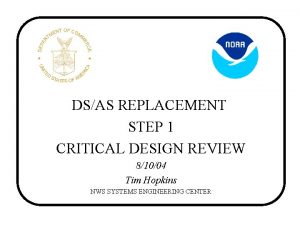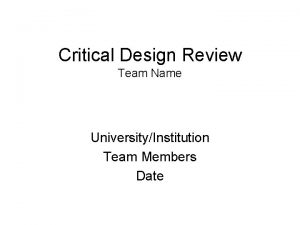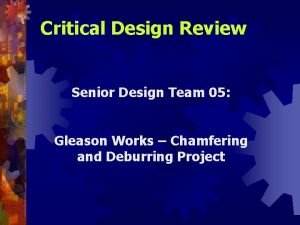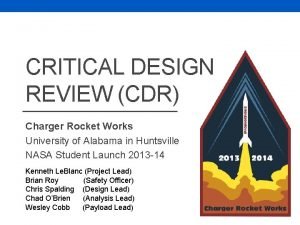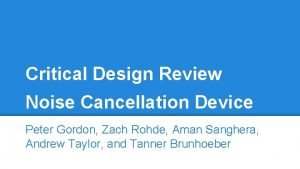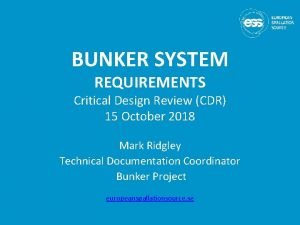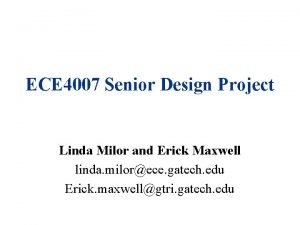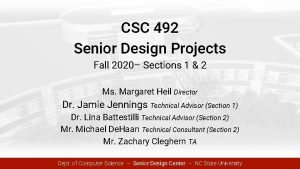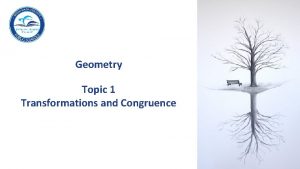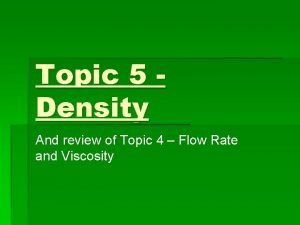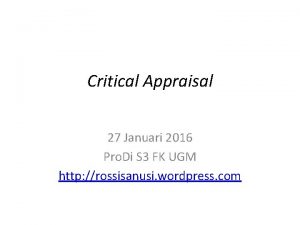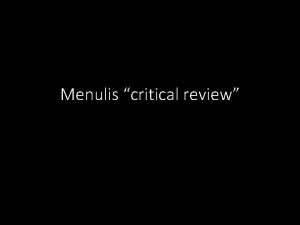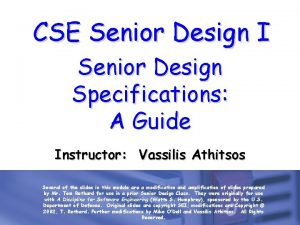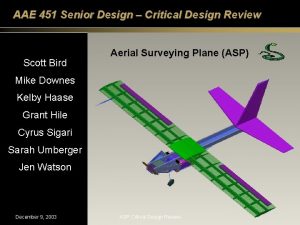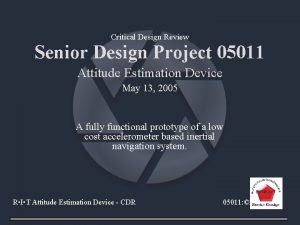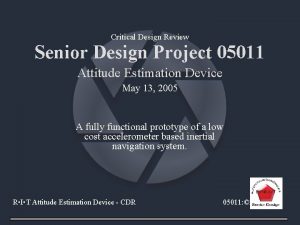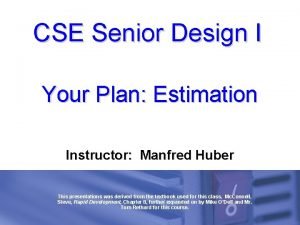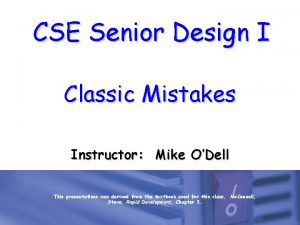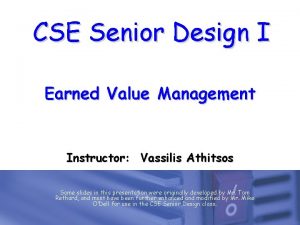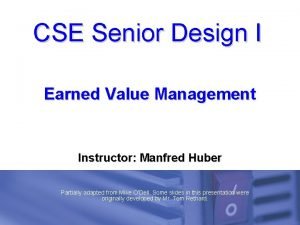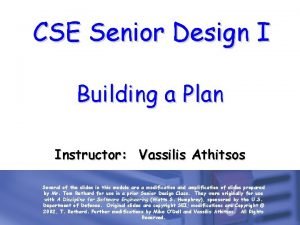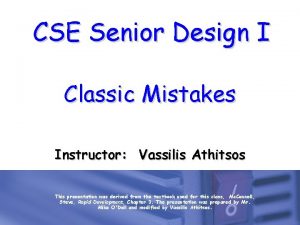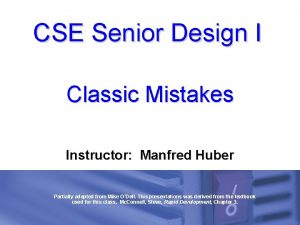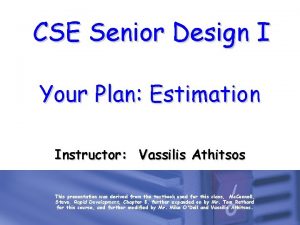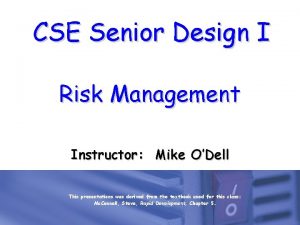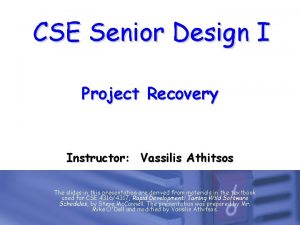CSE Senior Design I Critical Topic Review Instructor





















































- Slides: 53

CSE Senior Design I Critical Topic Review Instructor: Mike O’Dell

CSE Senior Design I Classic Mistakes Instructor: Mike O’Dell This presentations was derived from the textbook used for this class: Mc. Connell, Steve, Rapid Development, Chapter 3.

1 Why Projects Fail - Overview Ø Five main reasons: § § § Failing to communicate Failing to create a realistic plan Lack of buy-in Allowing scope/feature creep Throwing resources at a problem 3

1 Categories of Classic Mistakes Ø People-related Ø Process-related Ø Product-related Ø Technology-related 4

1 Classic Mistakes Enumerated 1. Undermined motivation: ü The Big One - Probably the largest single factor in poor productivity ü Motivation must come from within 2. Weak personnel: ü The right people in the right roles 3. Uncontrolled problem employees: ü Problem people (or just one person) can kill a team and doom a project ü The team must take action… early ü Consider the Welch Grid 5

1 Classic Mistakes Enumerated 4. Heroics: ü Heroics seldom work to your advantage ü Honesty is better than empty “can-do” 5. Adding people to a late project: ü Productivity killer ü Throwing people at a problem seldom helps 6. Noisy, crowded offices: ü Work environment is important to productivity ü Noisy, crowded conditions lengthen schedules 6

1 Classic Mistakes Enumerated 7. Friction between developers and customers: ü Cooperation is the key ü Encourage participation in the process 8. Unrealistic expectations: ü Avoid seat-of-the-pants commitments ü Realistic expectations is a TOP 5 issue 9. Lack of effective project sponsorship: ü Management must buy-in and provide support ü Potential morale killer 7

1 Classic Mistakes Enumerated 10. Lack of stakeholder buy-in: ü Team members, end-users, customers, management, etc. ü Buy-in engenders cooperation at all levels 11. Lack of user input: ü You can’t build what you don’t understand ü Early input is critical to avoid feature creep 12. Politics placed over substance: ü Being well regarded by management will not make your project successful 8

1 Classic Mistakes Enumerated 13. Wishful thinking: ü Not the same as optimism ü Don’t plan on good luck! luck ü May be the root cause of many other mistakes 14. Overly optimistic schedules: ü Wishful thinking? 15. Insufficient risk management: ü Identify unique risks and develop a plan to eliminate them ü Consider a “spiral” approach for larger risks 9

1 Classic Mistakes Enumerated 16. Contractor failure: ü Relationship/cooperation/clear SOW 17. Insufficient planning: ü If you can’t plan it… you can’t do it! 18. Abandonment of planning under pressure: ü Path to failure ü Code-and-fix mentality takes over… and will fail 10

1 Classic Mistakes Enumerated 19. Wasted time during fuzzy front end: ü That would be now! now ü Almost always cheaper and faster to spend time upfront working/refining the plan 20. Shortchanged upstream activities: ü See above… do the work up front! front ü Avoid the “jump to coding” mentality 21. Inadequate design: ü See above… do the required work up front! front 11

1 Classic Mistakes Enumerated 22. Shortchanged quality assurance: ü Test planning is a critical part of every plan ü Shortcutting 1 day early on will likely cost you 3 -10 days later ü QA me now, or pay me later! 23. Insufficient management controls: ü Buy-in implies participation & cooperation 24. Premature or overly frequent convergence: ü It’s not done until it’s done! 12

1 Classic Mistakes Enumerated 25. Omitting necessary tasks from estimates: ü Can add 20 -30% to your schedule ü Don’t sweat the small stuff! 26. Planning to catch up later: ü Schedule adjustments WILL be necessary ü A month lost early on probably cannot be made up later 27. Code-like-hell programming: ü The fast, loose, “entrepreneurial” approach ü This is simply… Code-and-Fix. Don’t! 13

1 Classic Mistakes Enumerated 28. Requirements gold-plating: ü Avoid complex, difficult to implement features ü Often, they add disproportionately to schedule 29. Feature creep: ü The average project experiences 25% change ü Another killer mistake! 30. Developer gold-plating: ü Use proven stuff to do your job ü Avoid dependence on the hottest new tools ü Avoid implementing all the cool new features 14

1 Classic Mistakes Enumerated 31. Push-me, pull-me negotiation: ü Schedule slip = feature addition 32. Research-oriented development: ü Software research schedules are theoretical, theoretical at best ü Try not to push the envelop unless you allow for frequent schedule revisions ü If you push the state of the art… it will push back! 33. Silver-bullet syndrome: ü There is no magic in product development ü Don’t plan on some new whiz-bang thing to save your bacon (i. e. , your schedule) 15

1 Classic Mistakes Enumerated 34. Overestimated savings from new tools or methods: ü Silver bullets probably won’t improve your schedule… don’t overestimate their value 35. Switching tools in the middle of the project: ü Version 3. 1…version 3. 2… version 4. 0! ü Learning curve, rework inevitable 36. Lack of automated source control: ü Stuff happens… enough said! 16

1 Recommendation: Develop a Disaster Avoidance Plan Ø Get together as a team sometime soon and make a list of “worst practices” that you should avoid in your project. Ø Include specific mistakes that you think could/will be made by your team Ø Post this list on the wall in your lab space or where ever it will be visible and prominent on a daily basis Ø Refer to it frequently and talk about how you will avoid these mistakes 17

CSE Senior Design I Your Plan: Estimation Instructor: Mike O’Dell This presentations was derived from the textbook used for this class, Mc. Connell, Steve, Rapid Development, Chapter 8, further expanded on by Mr. Tom Rethard for this course.

1 The Software-Estimation Story Ø Software/System development, and thus estimation, is a process of gradual refinement. Ø Can you build a 3 -bedroom house for $100, 000? (Answer: It depends!) Ø Some organizations want cost estimates to within ± 10% before they’ll fund work on requirements definition. (Is this possible? ) Ø Present your estimate as a range instead of a “single point in time” estimate. Ø The tendency of most developers is to underestimate and over-commit! 19

1 Estimate-Convergence Graph Project Cost (effort and size) Project Schedule 1. 6 4 2 1. 5 Hig h. E stim ate 1. 25 1. 0 0. 8 0. 67 0. 5 0. 25 Initial product definition Low ate m i t Es Approved Requirements Product Detailed product specification design definition specification 1. 25 1. 1 1. 0 0. 9 0. 85 0. 8 0. 6 Product complete 20

1 Estimation tips Avoid off-the-cuff estimates Allow time for the estimate (do it right!) Use data from previous projects Use developer-based estimates Estimate by walk-through Estimate by categories Estimate at a low-level of detail Don’t forget/omit common tasks Use software estimation tools Use several different techniques, and compare the results Ø Evolve estimation practices as the project progresses Ø Ø Ø Ø Ø 21

1 Function-Point Estimation Ø Based on number of § Inputs (screens, dialogs, controls, messages) § Outputs (screens, reports, graphs, messages) § Inquiries (I/O resulting in a simple, immediate output) § Logical internal files (Major logical groups of end-user data, controlled by program) § External interface files (Files controlled by other programs that this program uses. Includes logical data that enters/leaves program) 22

1 Function-Point Multipliers Program Characteristic Number of inputs Number of outputs Inquiries Logical internal files External interface files Low Complexity 3 4 3 7 5 Function Points Medium Complexity 4 5 4 10 7 High Complexity 6 7 6 15 10 Sum these to get an “unadjusted function-point total” Multiply this by an “influence multiplier” (0. 65 to 1. 35), based on 14 factors from data communication to ease of installation. All of this gives a total function-point count. Use this with Jones’ First-Order Estimation Practice, or compare to previous projects for an estimate 23

1 Estimate Presentation Styles Ø Plus-or-minus qualifiers “ 6 months, +3 months, -2 months” Ø Ranges “ 5 -9 months” Ø Risk quantification “ 6 months. . . +1 month for late subcontractor, +0. 5 month for staff sickness, etc. . . ” Ø Cases Best case Planned case Current case Worst case April 1 May 15 May 30 July 15 Ø Coarse dates and time periods “ 3 rd quarter 97” Ø Confidence factors April 1 May 15 July 1 5% 50% 95% 24

1 Schedule Estimation Ø Rule-of-thumb equation § schedule in months = 3. 0 * man-months 1/3 This equation implies an optimal team size. Ø Use estimation software to compute the schedule from your size and effort estimates Ø Use historical data from your organization Ø Use Mc. Connell’s Tables 8 -8 through 8 -10 to look up a schedule estimate based on the size estimate Ø Use the schedule estimation step from one of the algorithmic approaches (e. g. , COCOMO) to get a more fine tunes estimate than the “Rule of thumb” equation. 25

1 Shortest Possible Schedule Table 8. 8 Probability of Completing Exactly on the Scheduled Date High Risk of late completion. Shortest possible schedule Scheduled Completion Date Impossible schedule • This tables assumes: - Top 10% of talent pool, all motivated, no turnover - entire staff starts working on Day 1, & continue until project released - advanced tools available to everyone - most time-efficient development methods used - requirements completely known, and do not change 26

1 Efficient Schedules (Table 8 -9) Ø This table assumes: § § § Top 25% of talent pool Turnover < 6% per year No significant personnel conflicts Using efficient development practices from Chap 1 -5 Note that less effort required on efficient schedule tables § For most projects, the efficient schedules represent “best-case” 27

1 Nominal Schedules (Table 8 -10) Ø This table assumes: § § § Top 50% of talent pool Turnover 10 -12% per year Risk-management less than ideal Office environment only adequate Sporadic use of efficient development practices § Achieving nominal schedule may be a 50/50 bet. 28

1 Estimate Refinement Ø Estimate can be refined only with a more refined definition of the software product Ø Developers often let themselves get trapped by a “single-point” estimate, and are held to it (Case study 1 -1) § Impression of a slip over budget is created when the estimate increases Ø When estimate ranges decrease as the project progresses, customer confidence is built-up. 29

1 Conclusions Ø Estimate accuracy is directly proportional to product definition. § Before requirements specification, product is very vaguely defined Ø Use ranges for estimates and gradually refine (tighten) them as the project progresses. Ø Measure progress and compare to your historical data Ø Refine… 30

CSE Senior Design I Feature-Set Control Instructor: Mike O’Dell The slides in this presentation are derived from materials in the textbook used for CSE 4316/4317, Rapid Development: Taming Wild Software Schedules, by Steve Mc. Connell.

1 The Problem Ø Products are initially stuffed with more features (requirements) than can be reasonably accommodated Ø Features continue to be added as the project progresses (“Feature-Creep”) Ø Features must be removed/reduced or significantly changed late in a project 32

1 Sources of Change Ø End-users: End-users driven by the “need” for additional or different functionality Ø Marketers: Marketers driven by the fact that markets and customer perspectives on requirements change (“latest and greatest” syndrome) Ø Developers: Developers driven by emotional/ intellectual desire to build the “best” widget 33

1 Effects of Change Ø Impact in every phase: phase design, code, test, documentation, support, training, people, planning, tracking, etc. Ø Visible effects: effects schedule, budget, product quality Ø Hidden effects: effects morale, pay, promotion, etc. Ø Costs are typically 50 -200 times less if changes are made during requirements phase, than if you discover them during implementation 34

1 Change Control Ø Goals: § Allow change that results in the best possible product in the time available Disallow all other changes § Allow everyone affected by a proposed change to participate in assessing the impact § Broadly communicate proposed changes and their impact § Provide an audit trail for all decisions (i. e. , document them well) § A process to accomplish the above as efficiently as possible 35

1 Late Project Feature Cuts Ø Goal: Eliminate features in an effort save the project’s schedule Ø Fact: Project may (will) fall behind for many reasons other than feature-set control Ø Fact: Removing features too late incurs additional costs and schedule impact Ø Approach: analyze the cost of removal and reusability, then strip out unused code, remove documentation, eliminate test cases, etc. 36

CSE Senior Design I Risk Management Instructor: Mike O’Dell This presentations was derived from the textbook used for this class: Mc. Connell, Steve, Rapid Development, Chapter 5.

1 Why Do Projects Fail? Ø Generally, from poor risk management § Failure to identify risks § Failure to actively/aggressively plan for, attack and eliminate “project killing” risks Ø Risk comes in different shapes and sizes § Schedule risks (short to long) § Cost risks (small to large) § Technology risks (probable to impossible) 38

1 Elements of Risk Management Ø Managing risk consists of: identifying, addressing and eliminating risks Ø When does this occur? ü WORST – Crisis management/Fire fighting : addressing risk after they present a big problem ü BAD – Fix on failure : finding and addressing as the occur. ü OKAY – Risk Mitigation : plan ahead and allocate resources to address risk that occur, but don’t try to eliminate them before they occur ü GOOD – Prevention : part of the plan to identify and prevent risks before they become problems ü BEST – Eliminate Root Causes : part of the plan to identify and eliminate the factors that make specific risks possible 39

1 Elements of Risk Management Ø Effective Risk Management is made up of: § Risk Assessment: identify, analyze, prioritize § Risk Control: planning, resolution, monitoring IDENTIFICATION RISK ASSESSMENT RISK MANAGEMENT ANALYSIS PRIORITIZATION PLANNING RISK CONTROL RESOLUION MONITORING 40

1 Risk Monitoring Ø Risks and potential impact will change throughout the course of a project Ø Keep an evolving “TOP 10 RISKS” list § See Table 5 -7 for an example § Review the list frequently § Refine… Ø Put someone in charge of monitoring risks Ø Make it a part of your process & project plan 41

CSE Senior Design I Overview: Software System Architecture Software System Test Mike O’Dell Based on an earlier presentation by Bill Farrior, UTA, modified by Mike O’Dell

1 What is System Design? Ø A progressive definition of how a system will be constructed: § Guiding principles/rules for design (Metaarchitecture) § Top-level structure, design abstraction (Architecture Design) § Details of all lowest-level design elements (Detailed Design) CSE 4317 43

1 What is Software Architecture? Ø A critical bridge between what a system will do/look like, and how it will be constructed Ø A blueprint for a software system and how it will be built Ø An abstraction: abstraction a conceptual model of what must be done to construct the software system § It is NOT a specification of the details of the construction CSE 4317 44

1 What is Software Architecture? Ø The top-level breakdown of how a system will be constructed: § § design principles/rules high-level structural components high-level data elements (external/internal) high-level data flows (external/internal) Ø Discussion: Architectural elements of the new ERB CSE 4317 45

1 System Architecture Design Process Ø Define guiding principles/rules for design Ø Define top-level components of the system structure (“architectural layers”) Ø Define top-level data elements/flows (external and between layers) Ø Deconstruct layers into major functional units (“subsystems”) Ø Translate top-level data elements/flows to subsystems CSE 4317 46

1 Layer Example: The Internet Protocol Stack Architecture Layers/Services: Ø application: supporting network applications application Ø transport: host-host data transfer transport § ftp, smtp, http § tcp, udp Ø network: routing of datagrams from source to destination § ip, routing protocols Ø link: data transfer between neighboring network elements § E. g. , Ethernet, 802. 11 WLAN network link physical Ø physical: bits “on the wire” 47 1: Introduction

1 Subsystem Example: The Internet Network Layer Transport layer: TCP, UDP Network layer IP protocol • addressing conventions • datagram format • packet handling conventions Routing protocols • path selection • RIP, OSPF, BGP routing table ICMP protocol • error reporting • router “signaling” Link layer Physical layer 4 b 4: Network 48 Layer

1 Criteria for a Good Architecture (The Four I’s) Ø Independence – the layers are independent of each other and each layer’s functions are internally-specific and have little reliance on other layers. Changes in the implementation of one layer should not impact other layers. Ø Interfaces/Interactions – the interfaces and interactions between layers are complete and well-defined, with explicit data flows. Ø Integrity – the whole thing “hangs together”. It’s complete, consistent, accurate… it works. Ø Implementable – the approach is feasible, and the specified system can actually be designed and built using this architecture. CSE 4317 49

1 How do you Document a Software Architecture? Ø Describe the “rules” : meta-architecture § guiding principles, vision, concepts § key decision criteria Ø Describe the layers § what they do, how they interact with other layers § what are they composed of (subsystems) CSE 4317 50

1 How do you Document a Software Architecture? Ø Describe the data flows between layers § what are the critical data elements § provider subsystems (sources) and consumer subsystems (sinks) Ø Describe the subsystems within each layer § what does it do § what are its critical interfaces of the subsystem, within and external to its layer § what are its critical interfaces outside the system CSE 4317 51

1 Final Thoughts – Verification System Definition SRD: System Requirements MAP: All Specified Requirements System Validation Test ADS: Architecture Specification MAP: All Subsystem & Layer Interfaces & Interactions Integration Test DDS: Detailed Design Specification MAP: All Module Interfaces & Interactions Component Test (a. k. a. Function Test) MAP: All Modules Implementation Unit Test System Verification CSE 4317 52

1 Final Thoughts – Verification Ø Unit Test: verifies that EVERY module (HW/SW) specified in the DDS operates as specified. Ø Component/Function Test: verifies integrity of ALL inter-module interfaces and interactions. Ø Integration Test: verifies integrity of ALL inter -subsystem interfaces and interactions. Ø System Verification Test: verifies ALL requirements are met. CSE 4317 53
 Critical semi critical and non critical instruments
Critical semi critical and non critical instruments Spaulding classification
Spaulding classification Cse senior
Cse senior Critical design review
Critical design review Critical design review template
Critical design review template Critical design review
Critical design review Cdr design review
Cdr design review Critical design review
Critical design review Cdr critical design review
Cdr critical design review Clincher ideas
Clincher ideas Narrow down the topic
Narrow down the topic Slidetodoc.com
Slidetodoc.com Senior design ucf
Senior design ucf Linda milor
Linda milor Ncsu csc senior design
Ncsu csc senior design Ee senior design project ideas
Ee senior design project ideas New global connections unit test
New global connections unit test Geometry topic 1 review
Geometry topic 1 review Topic 3 review questions civilizations of asia answers
Topic 3 review questions civilizations of asia answers Formula of density
Formula of density Ucl critical review
Ucl critical review Literature map example
Literature map example Critical review example
Critical review example Contoh critical appraisal jurnal systematic review
Contoh critical appraisal jurnal systematic review Tipo de participantes
Tipo de participantes Basic instructor course tcole
Basic instructor course tcole Basic instructor course texas
Basic instructor course texas Basic instructor course texas
Basic instructor course texas Pepperball training manual
Pepperball training manual Neither of my two suitcases is adequate for this trip
Neither of my two suitcases is adequate for this trip Instructor vs teacher
Instructor vs teacher Cisco certified instructor
Cisco certified instructor Mptc firearms
Mptc firearms Basic instructor course #1014
Basic instructor course #1014 Basic instructor course #1014
Basic instructor course #1014 Virtual instructor.com
Virtual instructor.com Nfpa 1403 instructor to student ratio
Nfpa 1403 instructor to student ratio Human factors instructor
Human factors instructor Instructor operating station
Instructor operating station Catia instructor
Catia instructor Instructor
Instructor Ac 61-98 plan of action
Ac 61-98 plan of action Tcole 1014 basic instructor course
Tcole 1014 basic instructor course Marksmanship instructor
Marksmanship instructor Nrp instructor toolkit
Nrp instructor toolkit Cisco instructor certification
Cisco instructor certification Wi cbrf registry
Wi cbrf registry Nra certified instructor logo
Nra certified instructor logo Naismith was an instructor of
Naismith was an instructor of Please clean the room before you live
Please clean the room before you live Tcole advanced instructor course
Tcole advanced instructor course Tcole advanced instructor course
Tcole advanced instructor course Jrotc marksmanship instructor course online
Jrotc marksmanship instructor course online 15 sec illusion
15 sec illusion



